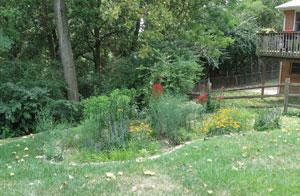Green Infrastructure Research

Water infrastructure may be considered “gray” or “green.” Gray infrastructure refers to traditional practices for storm water management and wastewater treatment. Green infrastructure refers to sustainable pollution reducing practices that also provide other ecosystem services such as reduced greenhouse gas emissions or increased flood control. Examples of green infrastructure include grass and forest buffers, use of porous materials for paving, as well as small-scale practices like rain gardens and rain barrels.EPA scientists are studying green infrastructure to determine the most effective and efficient practices for water treatment, management and transport.
Links
Featured Stories:
Science Matters: Why Study Green Infrastructure?
Science Matters: Stormwater Calculator to Manage Rainfall Runoff
Science Matters: Helping Cities Benefit from Green Infrastructure
Science Matters: Showing Buried Streams the Daylight
Science Matters: Tapping Green Infrastructure to Curb Sewer Overflows
Science Matters: Can Rain Barrels and Gardens Help Keep Sewage in the Sewers?
Science Matters: Parking Lots: Letting It Soak In
Other Links:
Green Infrastructure Research Fact Sheet (PDF)
Green and Gray Infrastructure Risk Management Research
Ecosystem Research – Green Infrastructure
Urban Detention Ponds
Evaluation of Urban Soils: Suitability for Green Infrastructure or Urban Agriculture
Lick Run: Green Infrastructure in Cincinnati and Beyond
National Stormwater Calculator
The Stormwater Calculator Fact Sheet (PDF)
Using Economic Incentives to Manage Stormwater Runoff in the Shepherd Creek Watershed, Part I
More on Green Infrastructure
